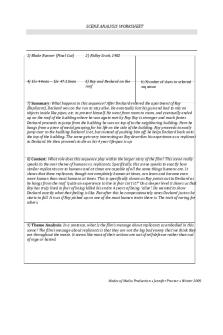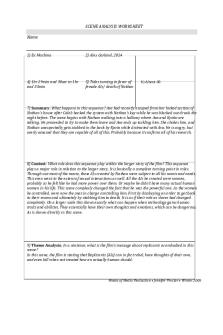Scene Analysis Worksheet PDF

| Title | Scene Analysis Worksheet |
|---|---|
| Course | Great Movies: |
| Institution | University of Kentucky |
| Pages | 4 |
| File Size | 131.7 KB |
| File Type | |
| Total Downloads | 48 |
| Total Views | 144 |
Summary
Mandatory Assignment, received an A ...
Description
SCENE ANALYSIS WORKSHEET
1) Blade Runner (Final Cut)
2) Ridley Scott, 1982
4) 1hr 44min – 1hr 47:15min
5) Roy and Deckard on the roof
6) Number of shots in selected sequence
7) Summary: What happens in this sequence? After Deckard entered the apartment of Roy (Replicant), Deckard was on the run to stay alive. He eventually lost his gun and had to rely on objects inside like pipes, etc. to protect himself. He went from room to room, and eventually ended up on the roof of the building where he was again met by Roy. Roy is stronger and much faster. Deckard proceeds to jump from the building he was on top of to the neighboring building. Here he hangs from a piece of metal grasping for his life on the side of the building. Roy proceeds to easily jump over to the building Deckard is at, but instead of pushing him off, he helps Deckard back onto the top of the building. The scene gets very interesting as Roy describes his experience as a replicant to Deckard. He then proceeds to die as his 4 year lifespan is up.
8) Context: What role does this sequence play within the larger story of the film? This scene really speaks to the over theme of humans vs. replicants. Specifically, this scene speaks to exactly how similar replicants are to humans and at times are capable of all the same things humans are. It shows that these replicants, though not completely human at times, can learn and become even more human than most humans at times. This is specifically shown as Roy points out to Deckard as he hangs from the roof “quite an experience to live in fear isn’t it?” On a deeper level it shows us that Roy has truly lived in fear of being killed his entire 4 years of being “alive”. He wanted to show Deckard exactly what that feeling is like. But after this he compassionately saves Deckard just as he starts to fall. It is as if Roy picked up on one of the most human traits there is. The trait of caring for others.
9) Theme Analysis: In a sentence, what is the film’s message about replicants as embodied in this scene? The film’s message about replicants is that they are not the big bad enemy that we think they are throughout the movie. It seems like most of their actions are out of self defense rather than out of rage or hatred.
Modes of Media Production • Jennifer Proctor • Winter 2009
Which of the following elements in your chosen sequence best contribute to the theme you’ve just identified? You don’t need to fill out all of these elements, but be sure to justify the choices you do make by filling out the Meanings section and explaining how the technical/style choices help contribute to your understanding of the scene. Be sure to use specific terms associated with the categories you choose. 10) Cinematography. The different uses of cinematography are very evident in this 3-minute scene. There is use of close ups, low-angle shots, and a POV shot. These all contribute to the overall meaning of the scene and ultimately the film.
Meanings. The first clear use of Cinematography is a slowly zooming in close up shot of Deckard as he is hanging on the building. The shot starts further out and zooms in on him grasping desperately for his life. It gives us as the audience a chance to see the struggle up close. Second, I noticed the use of a low angle shot up at Roy as he looks down on Deckard. It gives the impression that tides have turned as Roy is not the “powerful one” and Deckard is the weak fearful character. This could also be a POV shot, as it looks like it is from the point of view of Deckard dangling off the building. This low angle affect is also noticed as Roy jumps from one building to the next. It gives us as the audience a clear view of him easily jumping from one side to another. Some could say it even seems like he’s jumping into a new form of human. A nicer, more compassionate one.
11) Mise-en-scène.
Meanings.
Modes of Media Production • Jennifer Proctor • Winter 2009
12) Editing.
Meanings.
Modes of Media Production • Jennifer Proctor • Winter 2009
13) Sound. Sound is clearly a big part of this scene, through both Diegetic and Non- Diegetic sounds. Through dialogue and movements/ actions by characters. Along with music that adds to the overall mood and a sense of fear throughout the scene.
Meanings. The music played throughout this scene is kind of dark and suspenseful. It is the type of music you could hear in a horror film. It makes you wonder what’s going to happen next. There is also dialogue throughout this scene, but what makes the dialogue especially important is that there is only dialogue between the 2 characters caught on camera. What they do say to each other is important to the overall theme. It’s not like they’re just rambling back and forth. In addition, every action you think should be accompanied with a sound is in fact accompanied by a sound. Every jump, push, step, slip, etc. has the equivalent sound. It just overall adds to the settings. Helps you feel like you are on the roof as well.
Modes of Media Production • Jennifer Proctor • Winter 2009...
Similar Free PDFs

Scene Analysis Worksheet
- 4 Pages

Mise-en-scene Worksheet
- 3 Pages

Ex-Machina Scene Analysis
- 3 Pages

Paper 1 - Scene Analysis
- 4 Pages

Jaws Scene Analysis
- 3 Pages

Scene Analysis - Grade: A
- 6 Pages

Blade Runner Scene Analysis
- 3 Pages

Maleficent Scene Analysis
- 5 Pages

Film Scene Analysis The Insider
- 1 Pages
Popular Institutions
- Tinajero National High School - Annex
- Politeknik Caltex Riau
- Yokohama City University
- SGT University
- University of Al-Qadisiyah
- Divine Word College of Vigan
- Techniek College Rotterdam
- Universidade de Santiago
- Universiti Teknologi MARA Cawangan Johor Kampus Pasir Gudang
- Poltekkes Kemenkes Yogyakarta
- Baguio City National High School
- Colegio san marcos
- preparatoria uno
- Centro de Bachillerato Tecnológico Industrial y de Servicios No. 107
- Dalian Maritime University
- Quang Trung Secondary School
- Colegio Tecnológico en Informática
- Corporación Regional de Educación Superior
- Grupo CEDVA
- Dar Al Uloom University
- Centro de Estudios Preuniversitarios de la Universidad Nacional de Ingeniería
- 上智大学
- Aakash International School, Nuna Majara
- San Felipe Neri Catholic School
- Kang Chiao International School - New Taipei City
- Misamis Occidental National High School
- Institución Educativa Escuela Normal Juan Ladrilleros
- Kolehiyo ng Pantukan
- Batanes State College
- Instituto Continental
- Sekolah Menengah Kejuruan Kesehatan Kaltara (Tarakan)
- Colegio de La Inmaculada Concepcion - Cebu






